Jesse Livermore and TigerSoft's Internal Strength Indicators
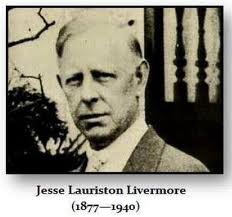
See ahttp://www.jesse-livermore.com/start-trading.html
Jesse Livermore
was a self-made man. He traded only his own money - not other
people's, like modern investment banks
and hedge funds. He was known as
the "Great Bear of Wall Street".
He made many million dollars selling short in the Crashes
of 1907-1908 and 1929-1932. He also lost
both fortunes in the bull markets that
followed each crash. One wonders if
he fell in love with the short side?
Did he only trade that way? Why?
It's much safer to play the trend. He didn't
have Peerless.
His thoughts on trading are extraordinarily
helpful because of the insights into
market psychology. His
"trading rules" are one of the foundations of modern
technical analysis. "To invest
or speculate successfully, one must form an opinion
as to what the next move of importance will be
in a given stock. Speculation is nothing
more than anticipating coming movements."
He believed in playing a trend he
believed would continue. Trading range
ups and downs did not interest him.
Most important, Jesse believed the best trading
opportunities occurred at key
"pivot points." He
said: "Whenever I have had the patience to wait for the market
to arrive at what I call a Pivotal Point
before I started to trade; I have always
made money in my operations."
In selling short he wanted prices to
confirm a downtrend by making a new after
an unsuccessful test of a previous low that had
held up for a while. The new lows could
be from a breakdown beklow support in a long,
horizontal trading range or it could
a new low after a false and short-term rally in
lomger-term downtrending stock. At the
pivot point prices Jesse' believed prices could
move up or down. He wanted prices
to turn down from the pivot point. This
would confirm his bearish judgement on the
stock and he would then go short.
He learned to wait for the breakdown at the pivot
point. He believed in letting the market
tell him that he was right.
With Tiger's Accumulation Index in red
territory and the Closing Power confirming thr
price weakness, it usually works out well to
sell short when the stock breaks below its
support. This is consistent with Jesse's
main trading tactic, selling short when a weak
stock turns down from a pivot point.
We also want to see the Relative Strength confirm
the new low, which it did in FSLR and WLT
below.
CP and AI Confirmed Fresh
Price Breakdowns Are Best Shorts
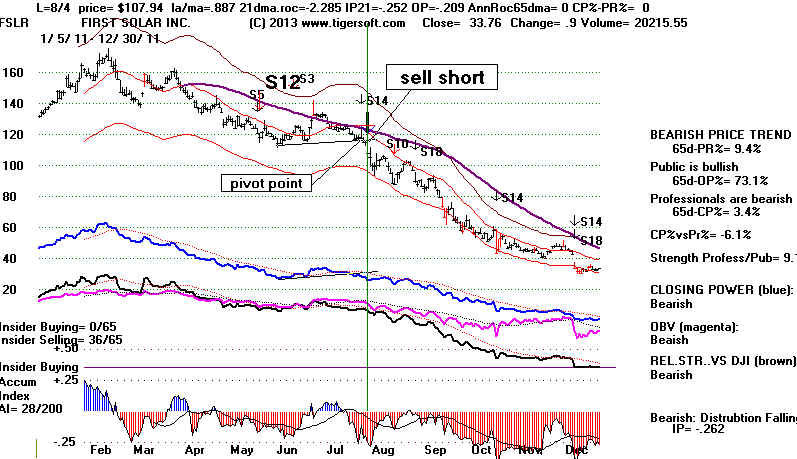
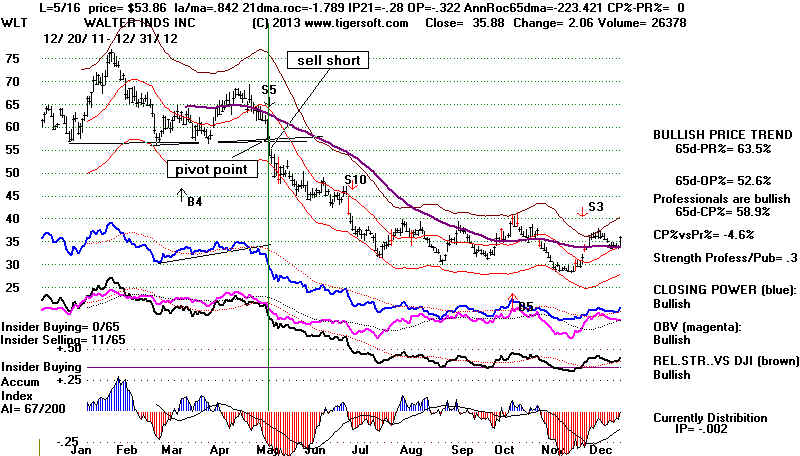
Jesse did not have the advantage of being
able to check the Tiger Internal Strength
Indicators to see if they confirmed the
new low. We must. Many of what prove to
be false new lows are clearly not
confirmed by Tiger's Closing Power, Accumulation
Index, OBV and Relative Strength Quotient
(RSQ).
Here are several examples of unconfirmed
breakdowns.
Accum. Index Failures To Confirm Fresh New Price Low
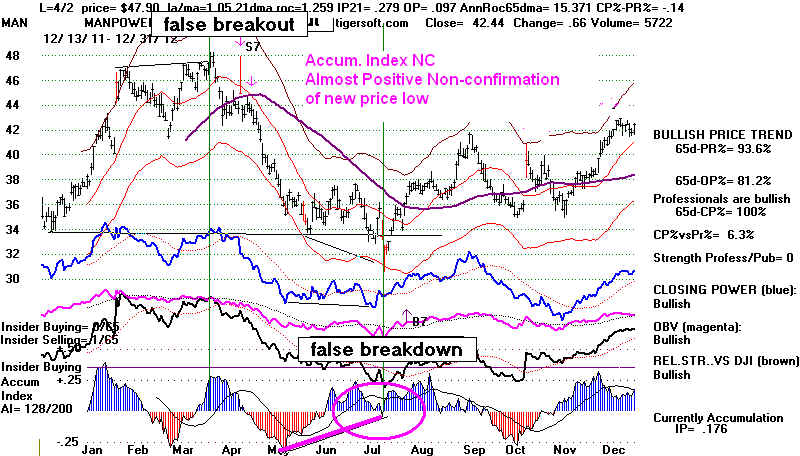
Decisiveness
Livermore advocated a quick decisiveness in going short. He wanted a buffer of profits
so
that he would not be scared into covering by a minor rally.
"I never benefited much from a
move if I did not get in at somewhere near the beginning
of
the move. And the reason is that I missed the backlog of profit which is very necessary
to
provide the courage and patience to sit thourgh a move until the end comes - and to
stay
through any minor reactions or rallies which were bound to occur from time to time
before
the movement had completed its course."
Now apply these ideas to BAC below (Bank of America).
By Livermore's and Tiger's
standards,
BAC was a very fine looking short sale candidate at above 33 in
late May
2008. In particular, notice the bottom of the Tiger charts just below. See
the daily
trading volume. Tiger shows volume in red if the stock fell and blue if the stock
advanced
for the day. For Livermore, it was important that the stock's trading volume
expand as
the stock fell and dimminish when it rose in minor counter-trend moves.
When volume
deviated from this pattern, it was a warning for him.
If prices then turned up,
he would
have covered his short sale.
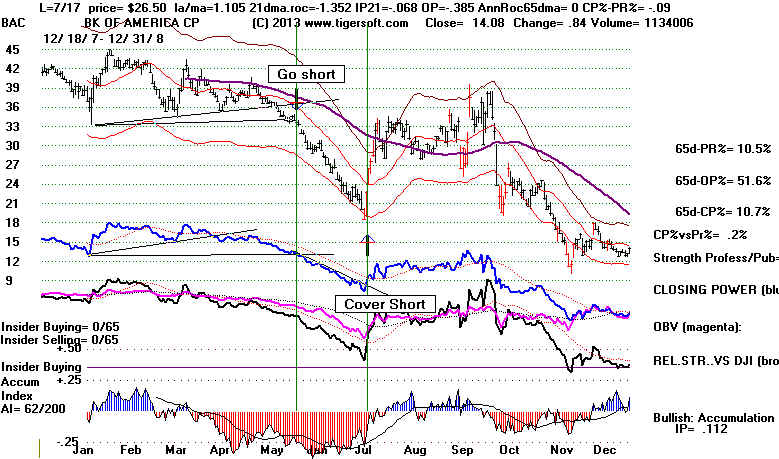

KNOWING WHEN TO SELL SHORT IS ONLY HALF THE BATTLE
KNOWING WHEN TO COVER THE SHORT IS THE OTHER HALF THE BATTLE
We watch the Blue Tiger Closing
Power trend. As long as it is below its
downtrend,
we can safely trust that Professionals are still bearish the stock
and we can
give it every chance to keep falling. But when the Blue Closing Power
breaks its
own downtrend-line, cover your short sale. This shows that Professionals
are turning
net bullish and there could be a "short squeeze".
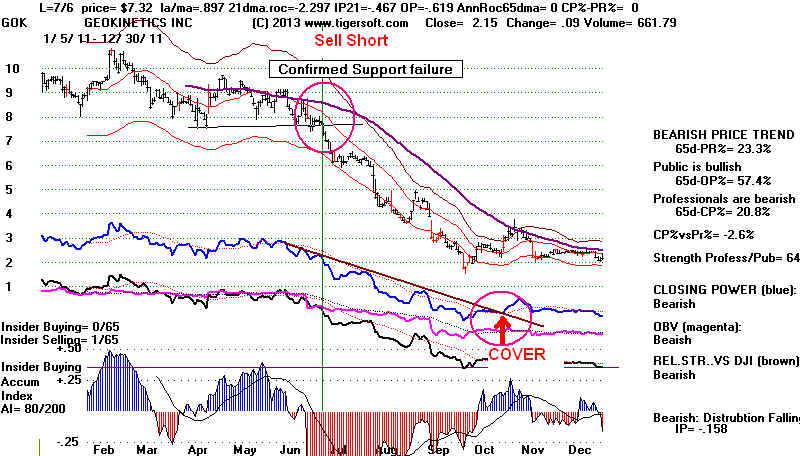
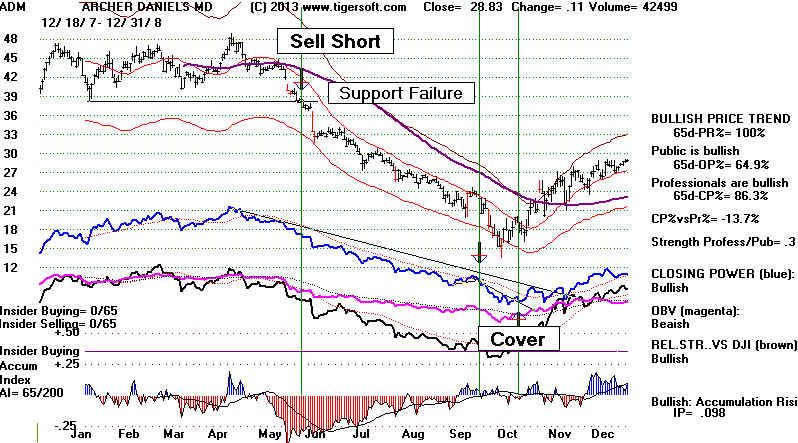
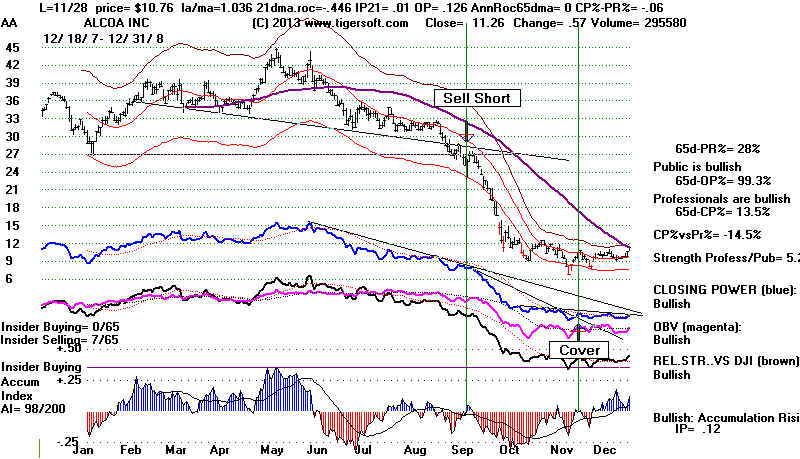
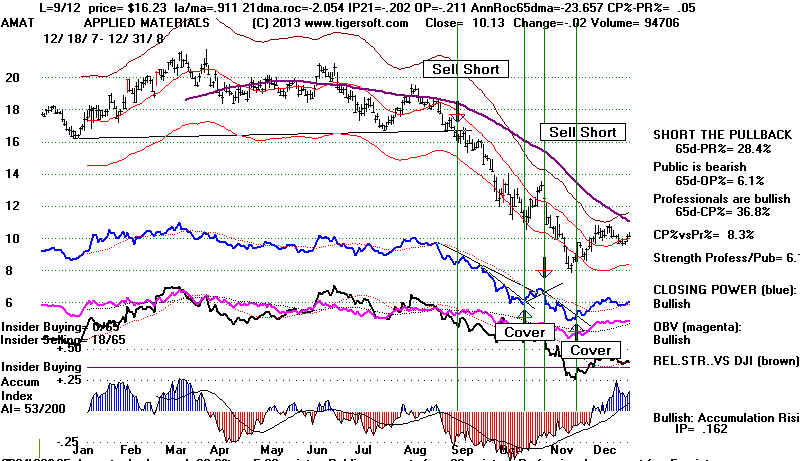
More of Livermore's Trading
Lessons
Livermore became
famous after the Panic of 1907 when he made a million selling stocks
short as the market crashed. He had noticed how buying power was drying
up and predicted
that there would be a
swift drop in prices as speculators were forced to sell because of
margin
calls and a lack of credit. See the details at
http://www.tigersoftware.com/TigerBlogs/May-20-2010-/index.html
In 1929, he
noticed market conditions were similar to those of 1907.
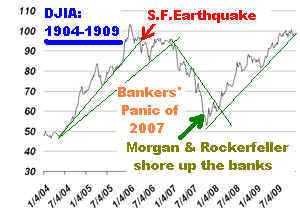
DO NOT FALL IN LOVE WITH THE SHORT SIDE.
You can in the DJI chart above, the DJI quickly recovred its losses of
2007 in 2008. Livermore
did not seem to profit from
this bull market. Did he make the mistake, I mentioned earlier, of
falling in love with the
short side and not switiching quickly enough to th ebuy side. It would seem so.
> Instead of making
investment decisions independently, after making millions in the Crash of 1907,
he listened to and heeded
another person's advice regarding Cottom and then added to a losing position.
Livermore is important to use now for the
working philosophy he set out for others on profitably trading
securities. It is said that
he often broke his own rules. While flexibility and pragmatism are important,
breaking his own rules can be a sign of
emotionalism coloring one's judgement. This is risky for the
cool and calculating short selling
trader.
Livermore's Quotes are extraordinarily
insightful for the would-be trader, long or short.
"All through time, people have basically acted and
reacted the same way in the market
as a result of: greed, fear, ignorance, and hope. That is why the numerical formations
and
(stock) patterns recur on a constant basis."
—Jesse Livermore, How To Trade In Stocks.
"The (stock) fluctuations were from the first associated in my mind with
upward or
downward movements. Of course there is always a reason for fluctuations, but the
tape
does not concern itself with the why and wherefore. It doesn't go into
explanations...
The reason for what a certain stock does today may not be known
for
two or three days, or weeks, or months. But what the dickens does that matter?
Your
business is with the tape now.... The reason can wait. But you must act instantly
or
be left. Time and again I see this happen."
...
"There are times when money can be made investing and speculating in stocks,
but
money cannot consistently be made trading every day or every week during
the
year. Only the foolhardy will try it. It just is not in the cards and cannot be
done."
"The point is not so much to buy as cheap as possible
or go short at top price,
but
to buy or sell at the right time."
"I am tired of hearing the public and papers blame Wall Street for parting fools
from
their money... It's the successful business man who is the biggest sucker of
the
lot. He has made a fortune in his own line. How? By being on the job for years;
by
learning all there was to know about it; by taking reasonable chances; by
utilizing
his knowledge and experience to anticipate probabilities."
"Speculation is far too exciting. Most people who speculate hound the brokerage
offices..the
ticker is always on their minds. They are so engrossed with the minor ups
and
downs, they miss the big moves."










